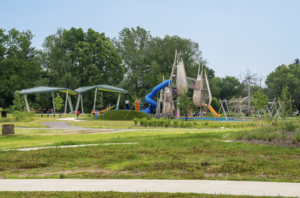Photographer / Daniel Woody
Once home to manicured fairways and golf carts, the northern edge of Riverside Regional Park has undergone a striking transformation. Now open to the public, Riverside Adventure Park invites visitors into a space that blends ecological restoration, inclusive recreation and the spirit of Indianapolis’ historic west side. As Phase 1 of a multi-phase vision, this new park is more than just a fresh set of trails and playgrounds — it is a major milestone in the reimagining of the White River corridor.
 A Century of Recreation, Reimagined
A Century of Recreation, Reimagined
Riverside Park dates back to the early 1900s, when it was one of the largest municipal parks in the country. Originally conceived as a unified greenspace under Mayor Thomas Taggart, it evolved into a series of distinct venues over time, including golf courses, cycling tracks and family centers. In recent decades, the golf courses, particularly Riverside and South Grove, saw reduced use and increasing maintenance challenges. This opened the door for something bold and community-driven.
The shift began in earnest in 2017 with the development of the Riverside Regional Park Master Plan. Through months of public meetings, workshops and surveys, residents overwhelmingly supported converting golf course acreage into natural parkland. According to the plan, the goal was to create ecologically sensitive, revenue-sustaining spaces that reconnected the neighborhood with the White River.
Phase 1: What’s Here Now
The newly opened Adventure Park spans the former Riverside Golf Course and includes a nature-inspired playground, multiple picnic shelters, paved trails and a fitness loop with outdoor exercise equipment. These amenities are designed with accessibility in mind, including ramps and smooth surfaces for users with mobility challenges.
What makes this park truly unique is its integration of natural elements. Mature trees were preserved, invasive species were removed and native plants were reintroduced. Wetlands and prairie zones now support pollinators and wildlife, and a scenic overlook offers expansive views of the river and skyline. A mural on the new restroom facility adds a splash of public art, and more creative installations are expected as the next phases roll out.
 Just across from the Adventure Park’s southern parking lot, near the 30th Street bridge, sits the headquarters of The Parks Alliance of Indianapolis, a key partner in the park’s ongoing revitalization. Sharing this space is Frank’s Paddlesports Livery, a local outfitter offering paddling experiences on the White River. With such easy access from the park, visitors can transition from land to water in minutes and experience the river’s beauty from an entirely new perspective.
Just across from the Adventure Park’s southern parking lot, near the 30th Street bridge, sits the headquarters of The Parks Alliance of Indianapolis, a key partner in the park’s ongoing revitalization. Sharing this space is Frank’s Paddlesports Livery, a local outfitter offering paddling experiences on the White River. With such easy access from the park, visitors can transition from land to water in minutes and experience the river’s beauty from an entirely new perspective.
A Park for the People, by the People
The Riverside planning process involved two steering committees, one technical and one community-based. Together, they evaluated concepts and ensured neighborhood voices shaped every step. More than 1,300 families were engaged directly through door-to-door outreach, and the response was clear: the community wanted more trails, nature play and cultural connection.
That feedback is now a reality. And even without a dedicated community center yet, Riverside Adventure Park is already seeing high usage. Families gather under shelters, children climb on nature-themed structures, and visitors pause at the overlook swing to take in the view. Indy Parks staff have spotted everything from bald eagles overhead to spontaneous community picnics below.
What’s Coming Next
Phase 2 of the park’s development will introduce a full archery range, supported by grant funding and expected to break ground in late 2025 or 2026. Phase 3, still in design, includes a nature center and education pavilion that will serve as a regional hub for environmental learning.
Throughout the park, elements like stacked river stone — used throughout the Riverside community since the early 20th century — will appear in signage and design features, creating a sense of continuity between past and present.
 Tied to a Larger Vision
Tied to a Larger Vision
Riverside Adventure Park is not just a standalone attraction. It is a key anchor in the broader White River Vision Plan, a multi-county initiative to revitalize 58 miles of riverfront with trails, parks and public programming. As part of this vision, the park connects directly to the Riverside Promenade, a pedestrian corridor that enhances mobility and honors the park’s cultural legacy.
According to Indy Parks, future signage and wayfinding tools will help link Riverside with other White River-connected spaces, building a regional identity and reinforcing the river as a shared community asset. The Adventure Park stands as a model for how riverfront land can be reimagined for ecology, equity and engagement.
Why It Matters
For residents of Indianapolis — especially those living near the Riverside neighborhood — the park represents more than a facelift. It is an investment in health, education and cultural recognition. It is a platform for environmental stewardship. And perhaps most importantly, it is a gathering space where the city’s past and future meet.
As one Indy Parks staff member put it, “Most of all, we love to see the activation of these spaces. We want people to come out, enjoy them and make them their own.”
With the trails open, the eagles flying and the White River flowing just steps away, Riverside Adventure Park is already doing just that.



 Tied to a Larger Vision
Tied to a Larger Vision

